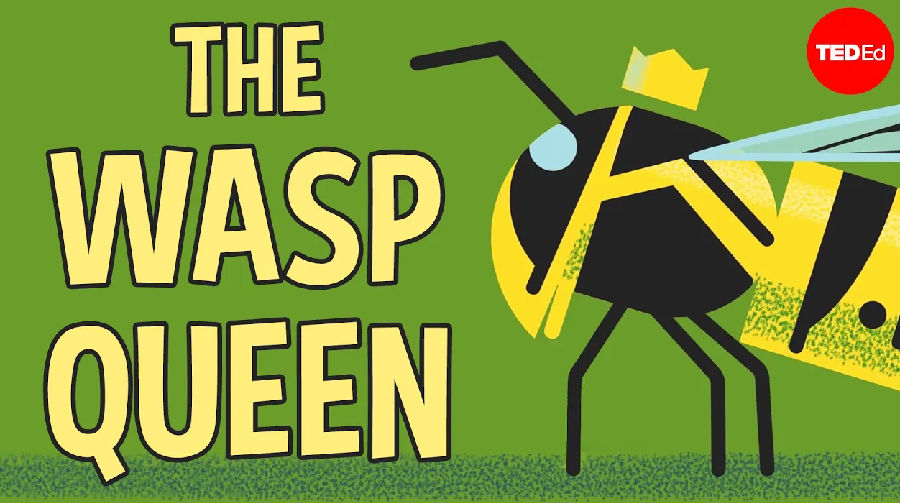As the April sun rises on a pile of firewood, something royal stirs inside.
四月,太阳从一堆木柴上方升起,皇室的气息开始在其中蔓延。
This wasp queen is one of thousands who mated in late autumn and hibernated through the winter.
这只黄蜂蜂后是上千只在去年秋天交配过的且冬眠熬过寒冬的蜂后中的一员。
Now she emerges into the spring air to begin her reign. Most of her sisters weren't so lucky.
现在,它在春风中苏醒,开始它的王朝。然而,它大多数的姐妹并没有这么幸运。
While hibernating in compost piles and underground burrows, many sleeping queens were eaten by spiders.
在堆肥和地洞中冬眠时,许多沉睡中的蜂后都被蜘蛛吃掉了。
Warm winters caused by climate change led other queens to emerge early, only to find there was no available food.
气候变化导致的暖冬使得许多蜂后们早早苏醒却发现无法找到食物。
And some queens that survived the winter fell victim to the threats of spring, such as carnivorous plants, birds, and manmade pesticides.
一些熬过冬天的蜂后则未能逃过春日危机,例如食虫植物、鸟类和人造杀虫剂。
Our queen is the lone survivor of her old hive, and now, she must become the foundress of a new one.
我们的蜂后是它旧蜂巢中的唯一幸存者,而现在,它必须成为一个新蜂巢的创建者。
But first, breakfast. The queen heads for a citrus grove full of honeybee hives.
但首要问题,是早餐。这位蜂后朝一片蜂巢遍布的柑橘林飞去。
The bees can be dangerous if provoked, but right now they're paralyzed by the morning cold.
这里的蜜蜂如果被激怒了将会非常危险,但现在它们在清晨的寒冷中动弹不得。
Their hairy bodies are dripping with sugar water from an earlier feeding, and the resourceful queen licks them for a morning snack.
它们毛茸茸的身体滴落着之前进食获得的糖水,而机智的蜂后舔食这些糖水当作清晨小食。
Newly energized, our queen searches for a safe nesting area. This tree hollow, safe from rain, wind, and predators, is ideal.
补充完能量,蜂后开始寻找安全的筑巢地。这棵中空的树很理想,防风雨又可抵御天敌。
She chews the surrounding wood and plant fibers to make a paper-like pulp.
它咀嚼周围木头和植物的纤维,来制造一种纸浆一样的浆状物。
Then she builds around 50 brood cells that comprise the beginning of her nest.
然后建造50个蜂室作为巢穴的基底。
Using sperm stored from last fall, the queen lays a fertilized egg into each cell, producing as many as 12 in 20 minutes.
借助去年秋天储存的精子,这只蜂后在每个蜂室中产下一枚受精卵,每20分钟产量高达12枚。
Within a week, these will hatch into female larva.
一周内,这些受精卵会孵化为雌性幼虫。
But until then, the queen must hunt down smaller insects to feed her brood, all while expanding the hive, laying eggs, and defending against intruders.
在那之前,蜂后必须捕食小昆虫来喂养幼卵,与此同时还要扩建巢穴、产卵、并抵御入侵者。
Fortunately, our queen is well prepared. Unlike bees, wasps can sting as many times as they need to.
还好,我们的蜂后做好了充足的准备。和蜜蜂不同,黄蜂的叮蛰没有次数限制。
With such a busy schedule, the queen barely has time to feed herself. Luckily, she doesn't have to.
在如此繁忙的行程下,蜂后基本没空进食。幸运的是,它也不一定需要。
When she feeds an insect to her grubs, they digest the bug into a sugary substance that sustains their mother.
当它给幼虫喂食昆虫时,幼虫会将虫子消化为含糖物质来供养母亲。

By the end of July, these first larva have matured into adult workers, ready to take on foraging, building, and defense.
等到七月末,最初的幼虫成长为成年工蜂,开始接手觅食、建造和防御的工作。
The queen can now lay eggs full-time, sustaining herself on her worker's spoils and their unfertilized eggs.
蜂后一心一意地开始产卵,依靠工蜂的供养和它们未受精的卵维持生存。
Although each worker only lives for roughly 3 weeks, the queen's continuous egg-laying swells their ranks.
尽管每只工蜂仅能存活大约三周的时间,但蜂后不停地产卵使得它们的队伍持续增长。
In just one summer, the nest reaches the size of a basketball, supporting thousands of workers.
仅仅一个夏天,巢穴就变得像篮球一样大,可供上千工蜂栖息。
Such a large population needs to eat, and the nearby garden provides a veritable buffet.
数量如此庞大的蜂群需要食物来维持,而旁边花园里名副其实的“自助餐”可以满足它们的需求。
As the swarm descends, alarmed humans try to swat them.
随着蜂群逼近,警惕的人类尝试拍打它们。
They even fight back with pesticides that purposefully poison wasps, and inadvertently impact a wide-range of local wildlife.
他们甚至使用专灭黄蜂的杀虫剂来回击,不经意间影响到了当地很多的野生动物。
But the wasps are actually vital to this ecosystem.
事实上,黄蜂对于生态系统非常关键。
Sitting at the top of the local invertebrate food chain, these insects keep spiders, mites, and centipedes, in check.
坐拥无脊椎动物食物链顶端,这些昆虫控制着蜘蛛、螨虫和蜈蚣的数量。
Wasps consume crop-eating insects, making them particularly helpful for farms and gardens.
黄蜂会消耗吃农作物的昆虫,以此帮助农田和花园。
They even pollinate fruits and vegetables, and help winemakers by biting into their grapes and jump-starting fermentation.
它们甚至帮助水果和蔬菜授粉,并且通过叮咬葡萄,使其快速启动发酵的方法来帮助酿酒人。
This feast continues until autumn, when the foundress changes course.
秋天,这场盛会随着蜂后目标的改变而落幕。
She begins grooming some eggs into a new generation of queens, while also laying unfertilized eggs that will mature into reproductive males called drones.
它开始将一些卵养育为新一代的蜂后,同时也继续产下未受精的可成长为工蜂的雄性生殖蜂。
This new crop of queens and males requires more food.
新出生的雌蜂和雄蜂需要更多的食物。
But with summer over, the usual sources run dry, and the foraging wasps start taking more aggressive risks.
但随着夏季的结束,食物来源消耗殆尽。觅食的黄蜂开始面对更多凶险。
By September, the hive's organization deteriorates. Hungry workers no longer clean the nest and various scavengers move in.
九月,蜂巢的组织体系逐渐恶化。饥饿的工蜂不再清理巢穴,于是许多清道夫侵入。
Just when it seems the hive can no longer sustain itself, the fertile queens and their drones depart in a massive swarm.
当巢穴无法再继续维持时,具有繁殖能力的蜂后和它的守护者们浩浩荡荡地离开了。
As the days grow colder, the workers starve, and our queen reaches the end of her lifespan.
随着天气逐渐寒冷,工蜂们会被饿死,我们的蜂后已走到了人生最后阶段。
But above, a swarm of reproductive wasps has successfully mated.
好在一群生殖黄蜂已成功交配。
The males die off shortly after, but the newly fertilized queens are ready to find shelter for their long sleep.
雄蜂不久之后就会死去,新受孕的蜂后也已经准备好去寻找冬眠的庇护所了。
And this woodpile looks like the perfect place to spend the winter.
这堆木柴看起来像是过冬的完美之地。


